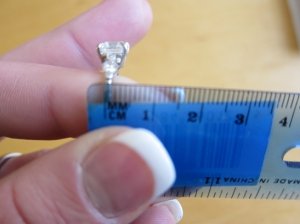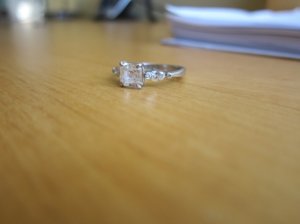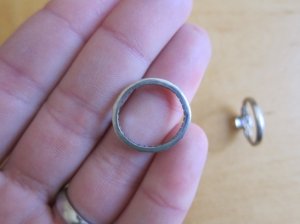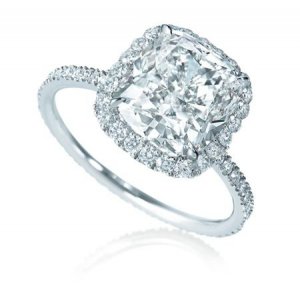NewEnglandLady
Ideal_Rock
- Joined
- Jul 27, 2007
- Messages
- 6,299
I honestly wish I'd done more research on the risks of thinner settings before DH bought my e-ring. I have LARGE hands, so I didn't want anything too delicate. I did, however, fall in love with a unique setting and parts of it were very thin.
I think that when most of us think about the durability of a thin setting, we think of it becoming out-of-round. This did happen with my ~2mm sapphire spacer (shown below), which, for me, isn't a dealbreaker. My spacer was made in the '20's, so I expected it to have some wear an tear.
But, my e-ring is a different story. It came from a high-end B&M here in Boston called Shreve, Crump and Low. When shopping, I stated that I wanted a very durable setting since I'm pretty active (and clumsy, to boot). I wanted a very low setting that could handle wear and tear. A solitaire was previously my first choice.
The head of my ring is always twisting. Anytime I hit my ring against anything, it twists slightly. I'm very sentimental about my e-ring and know that if the metal keeps twisting, eventually it will break. I wear my ring MAYBE once a month at most. I just pulled it out of its box to take a quick picture. You can see how it's slightly twisted...I can bend it back in place and I guarantee that next time I wear it, this will happen again.



I think that when most of us think about the durability of a thin setting, we think of it becoming out-of-round. This did happen with my ~2mm sapphire spacer (shown below), which, for me, isn't a dealbreaker. My spacer was made in the '20's, so I expected it to have some wear an tear.
But, my e-ring is a different story. It came from a high-end B&M here in Boston called Shreve, Crump and Low. When shopping, I stated that I wanted a very durable setting since I'm pretty active (and clumsy, to boot). I wanted a very low setting that could handle wear and tear. A solitaire was previously my first choice.
The head of my ring is always twisting. Anytime I hit my ring against anything, it twists slightly. I'm very sentimental about my e-ring and know that if the metal keeps twisting, eventually it will break. I wear my ring MAYBE once a month at most. I just pulled it out of its box to take a quick picture. You can see how it's slightly twisted...I can bend it back in place and I guarantee that next time I wear it, this will happen again.







300x240.png)